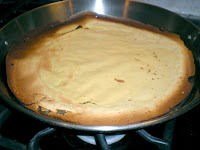I love stories. Especially when they involve food and/or travel. In my opinion, a good cookbook MUST have a good story behind it. If it doesn't, I lose interest in everything about it, including the recipes. One thing I'm most fond about Patricia Wells's cookbooks is their readability. She's a fine story teller and goes to length to include the history or background of a dish. Her opening narratives are welcoming, as if she is having you to dinner, yet still read like fine prose. Not what one might expect from your average cookbook, but something I've come to appreciate and admire about hers.
At Home in Provence, a collection of farmhouse recipes is indeed my favorite of her cookbooks. It squashes that idea that French food should be drowned in oil and heavy sauces. They can be, but not always. The cookbook is loaded with flavorful, aromatic, homey recipes and luscious photography. She also uses an occasional rebellious technique, as far as traditional French cooking goes. My kinda cooking! Chapters are dedicated to pastas and salads and breads, proving that French cuisine can be relaxed, yet abundantly flavorful. This particular book inspired a series of classes my sister and I will teach this spring and summer at Upper Arlington's Lifelong Learning; one of the country's largest adult enrichment programs. View the link here, if you'd like to register.
 I just participated in a month long challenge making at least three recipes per week for four weeks from the Salad as a Meal cookbook (SAAM). I will not go into too much detail here as there are about a dozen blogs just prior to this entry about the extremely fun and gratifying experience that I and seven others were selected to blog about. Like her other cookbooks, SAAM offers a fun, story-telling narrative with stories about each recipe, where they came from or a little about the region. Overall this cookbook's recipes show a huge range in the definition of salad, with which I wholeheartedly agree after making nearly twenty of them. When it comes to fabulous story- telling and darn good recipes Patricia Wells continues to be my culinary hero(ine)!!
I just participated in a month long challenge making at least three recipes per week for four weeks from the Salad as a Meal cookbook (SAAM). I will not go into too much detail here as there are about a dozen blogs just prior to this entry about the extremely fun and gratifying experience that I and seven others were selected to blog about. Like her other cookbooks, SAAM offers a fun, story-telling narrative with stories about each recipe, where they came from or a little about the region. Overall this cookbook's recipes show a huge range in the definition of salad, with which I wholeheartedly agree after making nearly twenty of them. When it comes to fabulous story- telling and darn good recipes Patricia Wells continues to be my culinary hero(ine)!!













